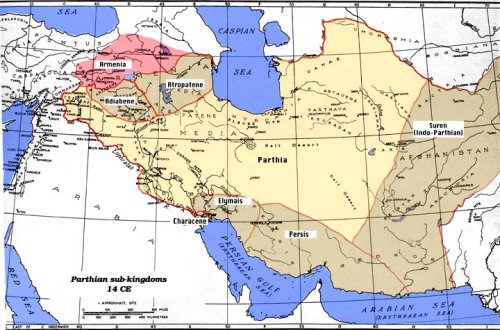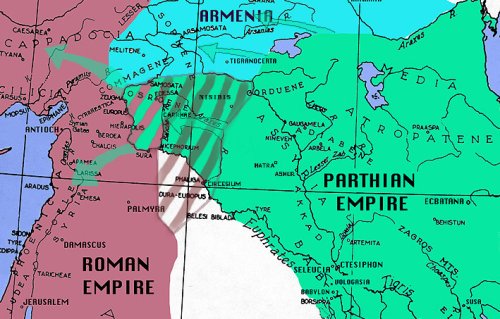Historical overview
History provides ample documentation to formulate the assumption that Mary is of Parthian-Scythian descent. Consequently, her son's biological aspect also points to the teaching of a faith and religious morality directly opposed to Jewish ideology. That opposition was apparently felt and resented by the Jews, as Josephus writes:
"The Jews always hated the Galileans."
It is impossible to write the history of early Christianity without a thorough understanding of the political and spiritual makeup and influence of an oft-hidden world power, the Parthian Empire. For five centuries, from 256 BC until 226 AD, the Parthian Empire, or more precisely, Parthian Monarchy, encompasses the territories of Iraq, Iran and beyond and, at times, Syria and Palestine. It is in this land that Jesus' disciples, the later apostles, teach Jesus' verb. It is evident that Judeo-Christianity's deliberate omission of the apostles' activities in Parthia, as well as its silence on the details of their works and the contents of their writings are of enormous importance to the interests of Judeo-Christianity's church politics.
The customary reference to the Parthians is the Parthian Empire. However, empire in this case is a misnomer. To be precise, it is a monarchy. The Arsacid Dynasty unites and rules all the feudal principalities and kingdoms of the Parthians' territories, similar to the centralization of power (to which they gave the title, [in free translation] the "lords of the four parts of the world") their predecessors, the Sumerians achieved with the accord of their city-states. One of these is the principality of Persia (the later Sassanids). Another is the Kingdom of Adiabene. However, all of these principalities and kingdoms are under the authority of the four kings of the Arsacid Dynasty who reign as monarchs over Armenia, Parthia, Indo-Parthia and Habdal-Hunnia (White Huns), in the Caspian-Aral-Oxus region. Due to the sheer size of their land, their political and military strength, the commonality of their race, language and religious beliefs, the Parthians are known as one of the three, distinct peoples of the time: Senecce Lucious Anneus (3-65 A.D.) writes:
"The gene pools of Mankind are the Greek, the Roman, and the Parthian."
West of the Parthian Empire is a much more publicized world power opposing Parthia, the Roman Empire. Here, relative ranking of contestants for power is set according to acquisition of new territory. Consequently, the Romans adopt expansionist policies. With the emergence and policies of this new world power, wars are frequent in Canaan, too, including wars among the Jewish tribes that resettle Southern Canaan after their release from Babylon, a region the Romans call Iudaea Province.

Map of "Parthian Sub-Kingdoms" in 14 A.D. according to current information propagation.
Understanding early Christianity also demands at least a quick review of the history of the region where Jesus is born. After the flood (around 5500 BC), Ut-nap-ishtim, popularly known as Noah, emerges in the region of the Ararat Mountains (Most scholars agree that the biblical flood is a rework of parts of the 3rd millennium BC Sumerian classic, Epic of Gilgamesh [Nib-Ur, biblical Nimrod], in which the Ararat Mountains is called Mount Nisir. “Gilgamesh is in reality Nimrod,” according to George Smith, Assyrian Discoveries, 1875, London). Ut-nap-ishtim's son, Canaan, along with his Sumerian people, settles on the eastern shores of the Mediterranean, a region later renamed in part as (variably) Lebanon, Phoenicia, Syria, Jordan, Palestine, Galilee, Samaria, Judea, and, later (1948), Israel. Here the Canaanites live peacefully according to their laws and religious beliefs; develop agriculture, fisheries and trade with their kindred in Egypt and Mesopotamia; and gradually improve their standard of living during the next 4000 years, suffering only relatively minor civic disturbances.
Then, an alien, Semitic people (led by Moses, according to the Talmud) of unknown origin (possibly Arabia), ousted from Egypt by the ruler of the 18-19th Dynasty (14-13th century BC), supposedly sets out to massacre the populations of the Canaanite cities in a historically unprecedented wave of genocide, claiming that their god told them to do so when he gave(!) them Canaan:
"When the Lord thy God shall bring thee into the land whither thou goest to possess it, and hath cast out many nations before thee, the Hittites, and the Girgashites, and the Amorites, and the Canaanites, and the Perizzites, and the Hivites, and the Jebusites, seven nations greater and mightier than thou; And when the Lord thy God shall deliver them before thee; thou shalt smite them, and utterly destroy them; thou shalt make no covenant with them, nor shew mercy unto them" (Deuteronomy 7:1-2).
The Canaanites (biblical Gog and Magog) halt the Hebrew invasion south of Sidon and gradually push the invaders back. The Bible gives an account of a certain David who is said to have committed such atrocities as the extermination of the inhabitants of entire cities, doings which turned him into the later Jews' biblical hero. It also gives an account of the Hebrews (who now call themselves Israel) carving up Canaan between a so-called “Twelve Tribes of Israel.” David's son, Salomon, becomes the king of the 12 tribes. After his death, the Kingdom of Israel splits into two; the 10 northern tribes constituting Israel, and the 2 southern tribes, Judea. However, these accounts appear to be, at best, historical fabrications written up retroactively, since no evidence of such kingdoms exist (Yigael Shiloh [Hebrew University]). Even during the so-called King Solomon's time, the region later called Galilee and Samaria separates the two supposed kingdoms, suggesting that the invading Hebrews failed to realize their plan, if any. In the 8th century BC, Sargon II occupies Samaria and deports the isolated Hebrew clans from Samaria and Galilee to the Habur river region in Media, and replaces them with people from Kuta (Kuti people, the Talmud calls them Samaritans) and other Mesopotamian cities. The ten so-called “Northern Tribes” disappear from biblical history, while the two “Southern Tribes” squat on the hill country of Southern Canaan (later Judea) as, according to Yigael Shiloh, “wondering pastoralists.”
In the 6th century BC, Nebuchadnezzar deports the Hebrews from Canaan to Babylon, Mesopotamia (biblical Babylonian Exile). The Babylonian Scythians welcome the deportees and allow them freedom to practice any religion they choose. It is here, in peaceful existence provided by a benevolent, affluent society and relative autonomy that the Hebrews conceive a new religious dictatorship, Judaism, which they retroactively write up nearly a thousand years later (200-500 AD) as the Talmud. Later, they will use their Babylonian power base to plot the overthrow of their benefactors. After the fall of Babylon in 537 BC, Cyrus allows the Jews to return to Southern Canaan—and many of them do.
By the Maccabean Period (2nd century BC), only a few isolated Jewish families live in Galilee. The last of the Jews leave Galilee when the Maccabean Simon Tharsi, after his victory over the Assyrians, gathers the remaining isolated Jewish families and, for security reasons, ships them back to Judea.
Then, in 129 BC, the first autonomous Jewish state (140-76 BC), the later Judea, occupies Samaria and, in 104 BC, Galilee as well. Aristobulus, king of Judea reigns for a year (104-103 BC) to be replaced by his half-brother, Alexander Jannaeus (103-76 BC). It is during this period that Janneus “experiments” with the Judaization of the conquered territories. He forces Judaism on the population, including the horrors of forced mutilation of all captured males, young and old, in the conquered territories.
In 63-64 BC, most of Canaan falls under Roman control, though the Jewish government enjoys a high degree of autonomy in Judea under the Romans. Soon after (60 BC), the first (Roman) triumvirate is formed by Caesar, Pompeius and Crassus. Seeking to outdo Caesar, Crassus, attacks the Parthians, but a Parthian scout force intercepts the Romans and routs their 30,000-strong army at Carrhae (Harran) in 53 BC. Crassus himself is killed. The region west of the Euphrates, including Northern Canaan (Galilee, Samaria and parts of Judea), fall under Parthian control, and become provinces of the Adiabene Kingdom, named after the Parthian royal prince appointed to govern it, Nakeb Adiabene (His title as governor was Pa-Kur [lord of the mountain region], referenced in biblical writings as Pacorus). The inhabitants are freed from the yoke of Judaism, lament their mutilated sons, and resume practicing their ancient faith openly.

Map of Parthian forces liberating Northern Canaan after defeating the Romans.
In 42 BC, Parthian King Bazapran, visits Adiabene province to join in the festivities planned for the wedding anniversary of its governor, Parthian Prince Nakeb Adiabene and his wife, Parthian Princess Grapte Kharax (also spelled, Charax)—whose name appears as the name of a city (and province) just south of Ur, Mesopotamia. At the same time, he reinforces Antigonus (Mathatias) of the Hasmoneus Dynasty, who becomes king of Jerusalem; and gives the Jews religious freedom. The rulers of the Parthian Empire are supporting the last descendants of the Maccabees, (the Hasmonean Dynasty) against Herod, whose oppressive policies they find so repulsive, they capture and imprison Herod's brother, Phasael, while Herod himself flees to Rome to avoid capture.
In response, Rome appoints Herod king of Jerusalem, and Roman legions land on the shores of Samaria, at Joppa to put Herod in power. Mark Anthony commands the legions, but Parthian forces repeatedly repel the Romans. However, two years later, Herod captures Jerusalem from the south via Idumea (Edom) in a bloodbath, killing large numbers of Sadducees. He also tries to force his way into Galilee, but runs into armed opposition as soon as he reaches Samaria and must sue for a peace treaty by way of the Parthian governor, Prince Adiabene.
This is the political situation in the region preceding Mary's birth. The Parthian Empire is at its peak: Its territories are no longer confined to the area that spans between the Euphrates and the Indus rivers, but include Galilee and Samaria where Prince Adiabene is governor. In light of these historical events, it is unreasonable to think of any Jewish population in Galilee until after the fall of the Jewish state and Jerusalem (2nd century AD). While it is plausible that a few Semites (Hebrews, Jews) had survived deportations, resettlement and evacuation, Galilee and Samaria are inhabited by a homogeneous Scythian (See below) population.

